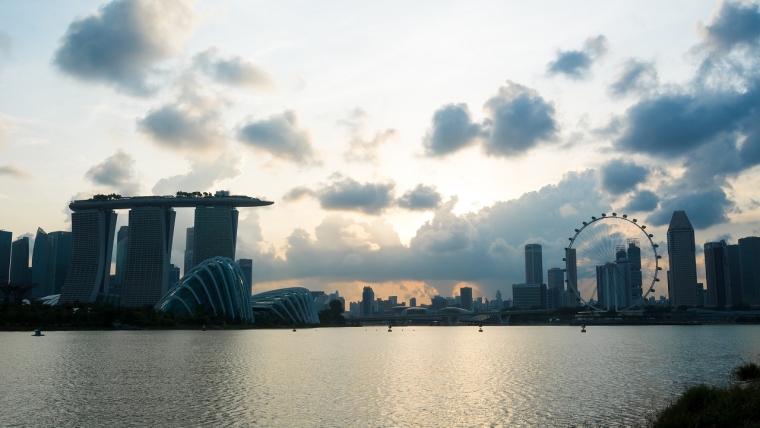
This is a re-post of an article originally published on pundit.co.nz. It is here with permission.
Singapore and New Zealand have much the same population – a bit over five million people. They are both affluent economies. Singapore is more affluent than New Zealand although there are reasons to believe the data exaggerates the differences. Because of their resource base and location they have rather different economic structures. Yet the two small economies work together in the international political economy.
New Zealand's land area is 368 times that of Singapore, so there is a lower population density and lower economies of agglomeration. (New Zealand’s EEZ is roughly 4000 times greater.)
The difference results in quite different economic structures. Compared to the typical affluent economy, New Zealand has a large natural resource sector based on the land and sea; Singapore's natural resource sector is negligible. As a consequence, if Singapore was located as far away as, say, the Falkland Islands, it would be as poor and as unpopulated as they are.
But it is not. Singapore is near the centre of the world economy. Almost half of the world's population lives in countries within 4000kms, producing over a third of the world's GDP. Both figures are increasing. Australia is the only a country of any significant size within the New Zealand 4000km-circle. Australasia has 0.4 percent of the world's population and 1.1 percent of its GDP.
(One OECD report estimated that reduced access to markets relative to the OECD average could reduce GDP per capita by as much as 11% in Australia and New Zealand. Conversely, a favourable impact of around 6-7% of GDP is found in the case of two centrally located countries: Belgium and the Netherlands. Singapore was not included in the study, but applying the latter figure to it, New Zealand's GDP would be depressed relative to Singapore by 17 percent, probably more.)
The structural consequence for the manufacturing and tradeable services sectors is that Singapore is involved with the web of Asian supply chains, whereas New Zealand manufacturing mainly consists of primary-product processing or small, localised market supply where importing would be too complicated or costly. Its businesses are rarely in the middle of supply chains, which have been one of the most dynamic international developments in recent times.
(A nice illustration of the difference between the two countries is that New Zealand is a supplier of milk powder to Singapore, which converts it into infant formula which it distributes throughout its region.)
Not only is Singapore central but it sits on the Straits of Malacca, a critical link in the international transport network. It is the international hub for the countries which encircle it.
So the two countries have quite different economic structures. Historically, New Zealand's main resource-based activity has been pastoral farming, with wool, meat and dairy products once making up over 90 percent of total foreign exchange earnings. A shrewd summary was that New Zealand was an 'exporter of processed grass' – processing through livestock and factory. Its comparative advantage was not so much its land – which is not particularly fertile – but a generous supply of sunlight and water. For a variety of reasons, there has since been a substantial diversification of the farm sector in the last decades into forestry, horticulture and wine over the last fifty years. Additionally, the fishing industry has boomed both offshore and with fish farming.
Perhaps the international tourist industry should be included among the 'resource-based' industries, given that scenery, as well as novelty, is a major appeal for one of New Zealand's biggest foreign-exchange earning industries. If the isolation adds to the attractions, it also puts New Zealand a long way from where the tourists live. In contrast, Singapore tourism arises from it being at the centre of that large Asian population – its local tourist attractions are primarily urban.
Both economies have the large service sector characteristic of a modern affluent economy. But Singapore’s financial and business sector is a major Asian and world centre; New Zealand's financial and business sector mainly services its domestic market. Singapore’s dominance arises from its location and a sound and robust domestic rule of law which has recently been strengthened by the weakening of Hong Kong with Beijing's increasing involvement in its affairs.
Their external structures for goods are quite different. Singapore’s exports of goods and services (including re-exports) amount to around 176 percent of its GDP, while its imports are 148 percent (in 2019); New Zealand's comparable figures are both 27 percent. The ginormous Singapore figure reflects its involvement in supply chains because of its near neighbours and location on the Malacca Straits. Its re-exports account for over two-fifths of Singapore's total sales to other countries in 2000. This is evident in that Singapore's principal exports are electronic components, refined petroleum, gold, computers, and packaged medications, while its principal imports are electronic components, refined petroleum, crude petroleum, gold, and computers. New Zealand's re-export proportion was nearer 4 percent, although this does not include imports of inputs such as oil and fertiliser, which are vital in the production of exports.
In the nineteenth century, New Zealand’s cables from Europe came through Singapore. Its defence was seen as critical to New Zealand; the ‘fall of Singapore’ in 1941 resounded through our thinking for decades, so much so that until recently we maintained an army base there. Once it was our key Asian international air terminal, including when we were flying west to Europe.
Such links have become more tenuous in today’s changing world of communications, but New Zealand and Singapore work together on a variety of international issues. Singapore's first international trade agreement still in force is the Closer Economic Partnership signed with New Zealand in 2001. It is our second; our first is the 1983 Closer Economic Relations with Australia, which replaced the 1966 New Zealand Australia Free Trade Agreement.
Evolving out of that partnership, the two countries have worked together on a range of other international deals including:
2005: Trans-Pacific Strategic Economic Partnership P4 - with Brunei and Chile;
2009: ASEAN-Australia-NZ FTA - 12 countries;
2018: Comprehensive and Progressive Agreement for Trans-Pacific Partnership (CPTTP) - currently 12 countries;
2022: Regional Comprehensive Economic Partnership (RCEP) - 15 countries.
Additionally, they are involved together in the following sectoral initiatives:
Digital Economy Partnership Agreement (DEPA);
WTO Joint Statement Initiative (JSI) on e-commerce;
Small Advanced Economies Initiative;
Singapore-New Zealand Declaration on Trade in Essential Goods.
(The last deserves special mention. It was signed in April 2020, just after the beginning of the COVID pandemic, to which it is a response, indicative of the warm and ongoing relationship between the two countries. Seven other countries have since made non-binding ministerial declarations.)
Some of these agreements are ‘open plurilateral’ - that is, they are designed to allow countries not involved in the original agreement to join (as happened with the United Kingdom joining CPTTP in 2023).
The commonality of the two countries arises from both being small. Each depends on a rules-based international trading order which favours unrestricted (or very limited restricted) trade. In a free-for-all world it is too easy for small nations to be bullied. Lee Kuan Yew's comment that whether elephants make love or war, the grass gets trampled, is apposite for New Zealand too.
*Brian Easton, an independent scholar, is an economist, social statistician, public policy analyst and historian. He was the Listener economic columnist from 1978 to 2014. This is a re-post of an article originally published on pundit.co.nz. It is here with permission.

We welcome your comments below. If you are not already registered, please register to comment
Remember we welcome robust, respectful and insightful debate. We don't welcome abusive or defamatory comments and will de-register those repeatedly making such comments. Our current comment policy is here.